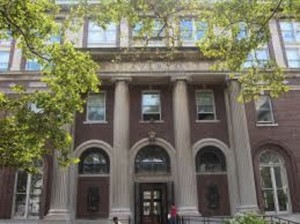PERENNIALOGY
Columbia Graduate School of Architecture, Planning, and Preservation starts study of perennial events.
Instructors:
Shohei Shigematsu [sshigematsu@oma.com]
Christy Cheng [cjc2101@columbia.edu]
The growing number of biennales and other similar events such as art fairs, expos and new types of museums shift away from the traditional gallery or museum. As the different types cross-pollinate and merge, a new model for art display, production, and market has emerged. It is within this new model that this studio positions itself, in intermediate space between art and architecture; architecture and landscape; art, architecture, and the city; architecture and the post-industrial urban condition. It can be argued that within this category, the appearance of the building or the building itself is no longer relevant, but that it is the works of art and the exhibitions and the public that define the museum. How can architects stake a claim in this model?
Although the first documented biennale was the Venice Biennale in 1895, the biennale / triennale/ quadriennal, or the perennial, has increased in number, influence, and popularity most rapidly within the past fifty years. First established by the Mayor of Venice Riccardo Selvatico as a way to transform the evening meetings of artists at the Caffé Florian into an international event, the Venice Biennale has since grown to include a number of different disciplines, but remains the original model for all that have followed. Now numbering over 150 worldwide (with some estimates as high as 200), the biennale has emerged as one of the main driving forces in the production, display, and distribution of art while simultaneously defining both the globalization and localization of urban cultural centers.
The Kochi-Muziris Biennale in India opened on December 12, 2012 and runned until March 13, 2013. Adding to the already long roster of biennales held in cities far from traditional Western economic or cultural hubs, the Kochi-Muziris Biennale is positioned to bring attention not only to Indian art, but also to the historical Kerala state in Southwestern India.
If the traditional Western model of the Biennale is defined by Venice, the alternative – or ʻSouthernʼ Biennale – has its roots in the Alexandria Biennale, first held in 1955. The Alexandria Biennale situated itself both politically, to commemorate the third anniversary of the Egyptian Revolution, and culturally, to promote artistic co-operation between Egypt and neighboring Mediterranean countries as well as the world. Biennales that followed such as the Gwangju Biennale in 1995, have also used the forum of the biennale to bring global attention to political and cultural issues. The increase in biennales has led to new disciplines of research in ʻbiennialogyʼ and ʻbiennale studiesʼ, and a new category of artist, the ʻbiennal artistʼ who shows repeatedly in city after city in biennales. The Biennial Foundation, founded in 2009, held the first World Biennial Forum in October 2012, in conjunction with the Gwangju Biennale, as an opportunity to provide critical reflection on the many biennales for art and related disciplines.
As biennales spread to increasingly less established and far flung locales, it has become even clearer that the biennale as an event is also being used to redefine new urban centers within rapidly growing economies. These events draw global attention to relatively remote locations, often taking place in former colonies and reflecting a shift towards post-colonial economic centers. Some of the most prominent biennales are currently held in the countries collectively known as BRICS – Brazil, Russia, India, China, South Africa. The second oldest biennale, the Sao Paulo Biennale, was established in 1951, while the 2010 Shanghai Biennale saw an upwards of 800,000 visitors in comparison to the 2012 Venice Biennalesʼ 620,000. In recent years the BRICS have positioned themselves as an alternative to a Western model of economics with their own development bank and bailout fund, strategically defining themselves as a new economic world order. In conjunction with these growing economies, there has been increased architectural and urban development in these countries, and as seen in events like the biennales, the development of new cultural and artistic initiatives.
Much like the ʻMillenium Park Effectʼ seen in Chicago, through the staging of a biennale, cities aim to create cultural venues that have economic and urban impacts using targeted financial investments. For the Kochi-Muziris Biennale, many of the venues were existing and unoccupied warehouses and halls which were rehabilitated for the event. Like a cultural Olympics, a Biennale is seen as a potential economic boom for a city by attracting global attention and tourism. These new biennales also typically have the common issues of disorganization and scheduling, as the traditionally European model is imported to new environments and must be adapted to local governmental, political, and cultural practices. Many of the venues and works of art were not ready for the grand opening of the Kochi-Muziris Biennale, leading critics and participants to refer to it as a ʻwork-in-progressʼ.
As the number of biennales has continued to grow, so have other similar events such as art fairs, expos, and new types of museums. While these categories range in terms of size, scale, and permanence, they all similarly reflect a shift away from the traditional gallery or museum. In its most permanent form, the new type of museum includes Inhotim, Naoshima, and Marfa. This type, with scattered displays that are defined as much by the landscape as by the actual art, has as its precedent the universal expo. As the different types cross-pollinate and merge, a new model for art display, production, and market has emerged. It is within this new model that this studio positions itself, in intermediate space between art and architecture; architecture and landscape; art, architecture, and the city; architecture and the post-industrial urban condition. It can be argued that within this category, the appearance of the building or the building itself is no longer relevant, but that it is the works of art and the exhibitions and the public that define the museum. How can we as architects stake a claim in this model?


